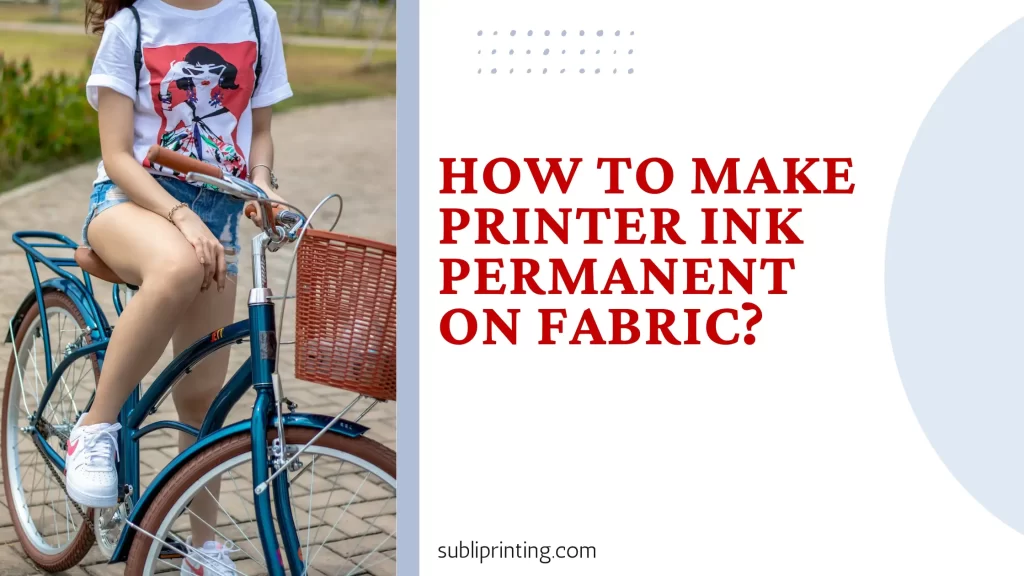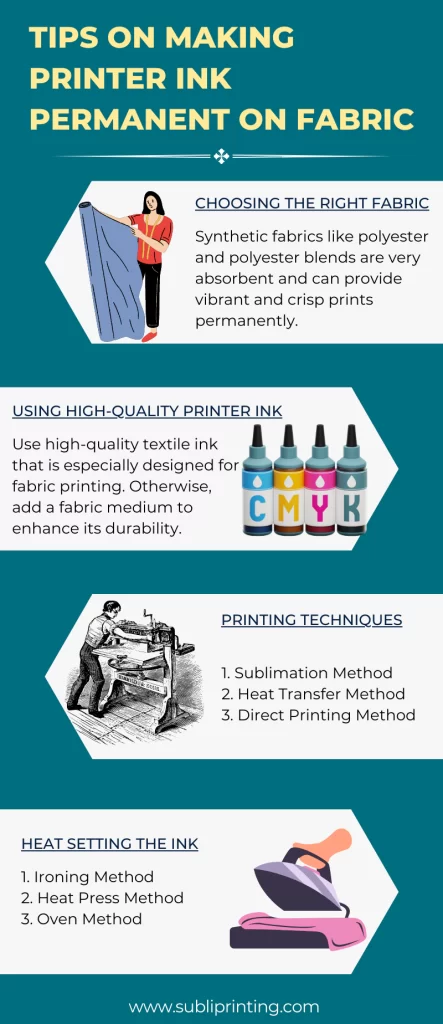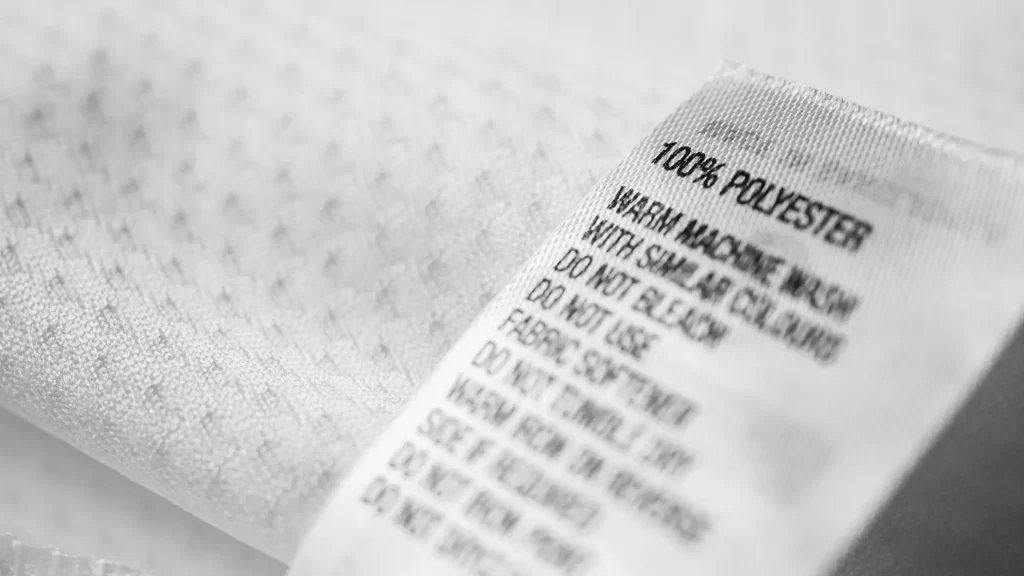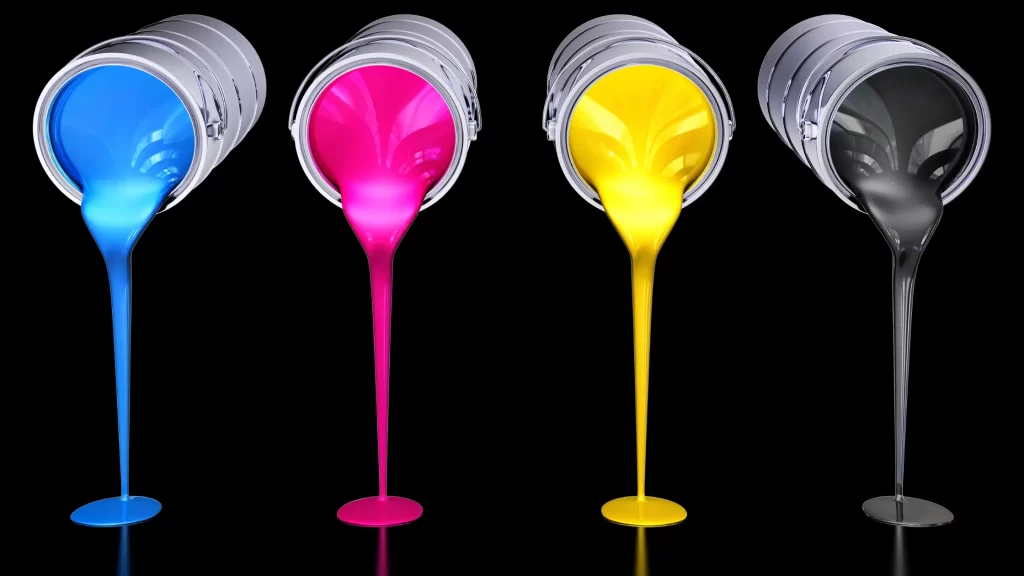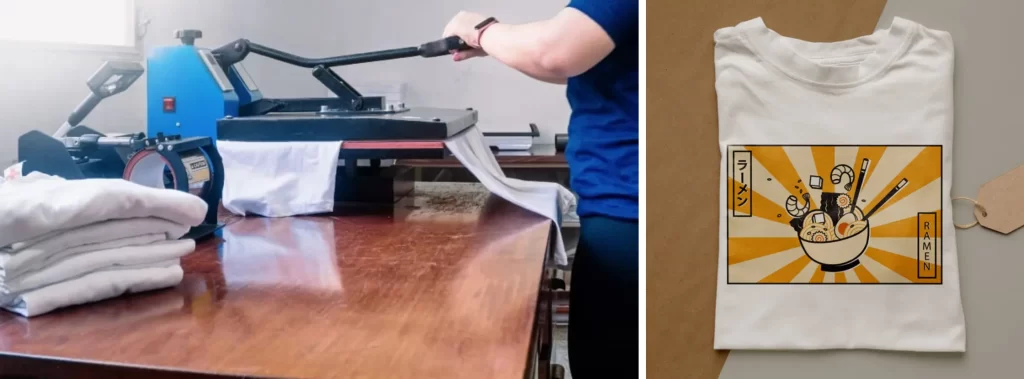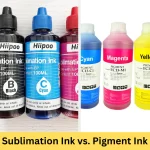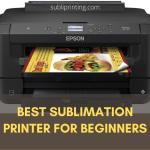In textile art and DIY projects, mastering the art of making printer ink permanent on fabric is a valuable skill. Whether you are creating custom t-shirts, personalized home decor, or unique fabric designs, ensuring the longevity of your prints is crucial.
Have you ever invested time and effort into creating a stunning print on fabric at home, only to have it fade away after a single wash? I’ve been there, and I know how frustrating it can be. That’s why I’ve put together this guide on how to make printer ink permanent on fabric and shared with you the invaluable lessons I’ve learned along the way.
Read if you can sublimate on microfiber too.
Contents
Expert Tips on Making Printer Ink Permanent on Fabric
As a DIY enthusiast, I’ve always loved personalizing my clothes and accessories with custom prints. But I’ve also learned the hard way that not all printer inks are created equal. Some inks fade quickly, while others bleed or crack when washed.
When I first started fabric printing, I was captivated by the endless creative possibilities it offered. However, I soon realized that achieving ink permanence on fabric was not as straightforward as I had hoped.
Countless hours of trial and error, coupled with faded prints and disappointing results, led me on a quest to uncover the expert tips that could make all the difference.
Note: from all the techniques like DTG (Direct to Garment), screen printing, or heat press, I’ve found sublimation produces permanent and vibrant results, perhaps that’s due to the sublimation ink and the sublimation printing process.
1. Choosing the Right Fabric
When it comes to making printer ink brighter and permanent on fabric, selecting the right fabric plays a crucial role. Not all fabrics are created equal when it comes to printing. Understanding the different fabric types and their suitability for printing is essential.
Fabrics like cotton, linen, and silk are popular choices due to their absorbency and smooth texture.
On the other hand, synthetic fabrics like polyester and polyester blends are very absorbent and can provide vibrant and crisp prints, thanks to their ability to hold the ink’s pigments.
However, always prepare the fabric before printing by washing it to remove any dirt or chemicals that may restrict ink absorption.
Additionally, consider using fabric pretreatment solutions specifically designed for enhancing ink vibrancy. You can use Krylon Fixative Spray to make the fabric ready to bond with ink pigments.
2. Using the High-Quality Printer Ink
To make printer ink permanent on fabric, consider using specialized fabric ink designed for printing on fabric, as it is formulated to stick and withstand washing.
If you are using regular inkjet ink, you can modify it by adding a fabric medium (certain additives or fixatives) to enhance its durability on fabric surfaces. I prefer using sublimation ink because it is fade-resistant, brighter, and offers long-lasting results.
However, if you are looking for an affordable and best ink for printing on fabric, I’ll recommend water-based textile pigment ink. These inks are easy to work with, non-toxic, and have good colorfastness. I have used water-based pigment inks to print on cotton, linen, and polyester. The inks have always produced vibrant colors that have held up well to washing and wear.
Whichever ink you choose, always test its colorfastness and compatibility with your fabric before proceeding. This can be done by printing a small sample and washing it to ensure the colors stay vibrant and don’t bleed or fade.
3. Printing Techniques to Make Ink Permanent on Fabric
When it comes to making printer ink permanent on fabric and achieving stunning prints, understanding various printing techniques is essential.
Setting up your printer correctly, optimizing the settings for optimal ink absorption, and exploring different fabric printing methods can make a significant difference in the final results.
Let’s get into the details:
a. Sublimation Method
Sublimation is an excellent technique for making printer ink permanent on fabric and achieving sharp, vibrant prints right in the comfort of your own home.
Let me take you through my personal experience with the sublimation method. It involves using a specialized sublimation printer, sublimation inks, sublimation transfer paper, and a heat press.
The process begins with designing a mirrored artwork, printing it onto the transfer paper, and placing it onto the fabric.
Using a heat press set to the 380°F to 400°F (193°C to 204°C) temperature, apply pressure for 50 to 60 seconds – the ink sublimates from a solid to a gas, fusing permanently with the fabric fibers.
After cooling, the transfer paper is peeled off, revealing vibrant and long-lasting prints that withstand washing and fading.
Can you sublimate on rayon fabric? Find the truth!
b. Heat Transfer Method
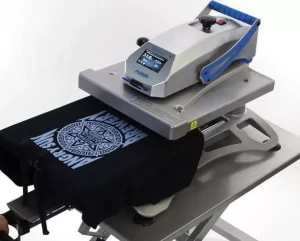
1. Start by selecting a design and printing it onto heat transfer paper using an inkjet printer.
2. Preheat your heat press machine to the 400°F (204°C) temperature.
3. Place the printed heat transfer paper with the design facing down onto the fabric.
4. Secure the fabric and transfer paper with heat-resistant tape to prevent shifting during the transfer process.
5. Position the fabric and transfer paper in the heat press, ensuring even pressure distribution.
6. Close the heat press and apply pressure for 60 seconds.
7. Once the transfer process is complete, carefully remove the fabric from the heat press and peel off the transfer paper to reveal your sharp and vibrant print.
Read comparison between sublimation vs heat transfer.
c. Direct Printing Method
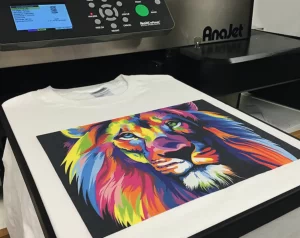
1. Start by selecting a design and preparing it for direct printing on fabric by taking care to align and size it correctly.
2. Ensure your printer is suitable for fabric printing and has the necessary features, such as an inkjet or laser printer.
3. Adjust the printer settings to accommodate the fabric type and desired print quality.
4. Pre-treat the fabric, if required, to enhance ink absorption and permanence.
5. Load the fabric into the printer, making sure it is aligned correctly for accurate printing.
6. Initiate the print process and allow the ink to fully dry before handling.
Read about DTG vs. Sublimation printing in detail.
4. Heat Setting the Ink on the Fabric Permanently
Heat setting ink is necessary to make printer ink permanent on the fabric due to the nature of the ink and the fabric bonding process. The heat setting method involves applying heat to the printed fabric, which helps the ink molecules penetrate and bond with the fabric fibers more effectively.
This process ensures that the ink becomes embedded within the fabric, making it resistant to washing, fading, and general wear and tear.
Without heat setting, the ink may not fully bond to the fabric, leading to inferior durability and the risk of the ink washing away or smudging over time.
After trying a few methods for heat setting, I’d love to share my trusted techniques that make a world of difference in the longevity and vibrancy of your prints.
a. Ironing Method
It’s convenient, and I can easily control the heat and pressure. I always set my iron to medium temperature in the beginning and then work my way up.
Placing a clean cloth or parchment paper over the print, I firmly press the iron, making sure to move it evenly across the design. Patience is key here; I give it enough time to cool before handling it.
b. Heat Press Method
For more extensive projects, or when I want flawless results, I turn to my trusty heat press. Let me tell you, it’s a game-changer.
Preheating the machine, positioning the fabric, and applying the right temperature and pressure settings – I feel like a pro. The heat press ensures an even and consistent heat distribution, resulting in brighter and long-lasting prints.
c. Oven Method
When I don’t have access to a heat press or iron, the oven method comes in handy. It’s not my go-to, but it gets the job done.
I preheat the oven, place the printed fabric on a baking sheet, and let it bake for about 2 minutes at 380°F temperature. It’s crucial to keep a close eye on it and make sure the fabric lays flat and doesn’t overlap.
Post-Treatment and Care: Keeping the Printer Ink Permanent on Fabric
Congratulations on successfully printing on fabric! Now, let’s talk about post-treatment and care to ensure the ink remains permanent and your prints stay vibrant for the long haul.
Taking proper care of your printed fabric is just as important as the printing process itself.
When it comes to washing and caring for the fabric after heat setting, it’s crucial to be gentle. Remember, you’ve put in the effort to make the ink permanent, and you want to preserve it as best as possible.
Opt for a gentle detergent that is specifically designed for delicate fabrics. Harsh chemicals and strong detergents can cause the ink to fade or deteriorate over time.
As for washing techniques, I highly recommend hand washing or using the delicate cycle on your washing machine. Avoid using excessive agitation or high-speed spins, as they can damage the ink. If possible, turn the fabric inside out before washing to minimize direct contact between the ink and other surfaces.
When drying your printed fabric, opt for air drying whenever possible. Hanging it on a clothesline is ideal. Avoid using a dryer, as the heat and tumbling can lead to unnecessary wear and tear on the ink.
To preserve the color and longevity of the printed fabric, here are a few additional tips:
- Before doing anything to the fabric, allow the ink to completely dry and settle down.
- Separate your printed fabric from other garments to prevent color bleeding.
- Avoid using harsh rubbing or scrubbing on the printed area.
- Avoid exposing the fabric to direct sunlight for extended periods, as it can cause fading.
- Iron the fabric on the reverse side or with a pressing cloth to avoid direct contact with the ink.
- Always use cold water for washing because hot water can cause the ink to bleed.
Conclusion
Achieving permanent printer ink on fabric requires careful consideration and the implementation of expert tips. We’ve explored the key steps for making inkjet printer ink permanent on fabric.
Whether it’s using the sublimation method for intricate designs, the heat transfer method for precise alignment, or the direct printing method for quick and convenient results, each technique has its own charm and advantages.
By choosing the right fabric, using high-quality ink, and employing effective heat setting methods like ironing, heat pressing, or oven heat setting, you can achieve vibrant and long-lasting prints at home.
Frequently Asked Questions
Does printer ink stay on fabric?
Printer ink does not typically stay on fabric permanently. However, there are a few things you can do to make printer ink more permanent on fabric.
One way is to use high-quality printer ink that is designed to be colorfast and fade-resistant. Another way is to use a heat press to set the ink. When you use a heat press, the heat and pressure help to bond the ink to the fabric fibers, making it more difficult for the ink to fade or wash away.
Can I use printer ink to dye fabric?
No, you cannot use printer ink to dye fabric. Printer ink is not designed to be used as a dye. It is also not colorfast and fade-resistant, which means that it will not produce durable or long-lasting results.
Can I use any type of printer ink for fabric printing?
No, not all printer inks are suitable for fabric printing. It is advised to use specialized fabric inks or modify regular inks with fabric medium for optimal results. These inks are formulated to bond well to fabric fibers and provide excellent colorfastness and durability.
Can I wash and care for the fabric as usual after heat setting the ink?
Yes, after heat setting the ink on fabric, it is generally safe to wash and care for the fabric as usual. However, wash it using gentle detergents and avoid harsh chemicals or bleach.
- 5 Best 13×19 Sublimation Printer for Wide Format Substrates - December 27, 2023
- Best 11×17 Sublimation Printer to Print Tabloid Size Paper - December 26, 2023
- Epson ET-8550 vs ET-15000: Best Wide-Format EcoTank Printer - December 25, 2023

